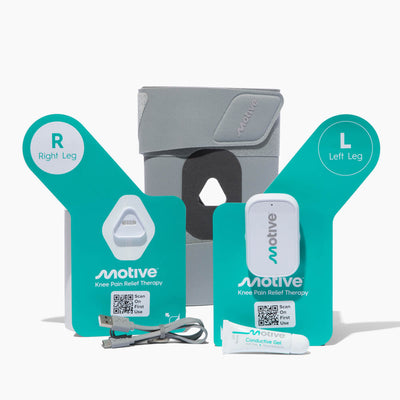
Imagine waking up every morning with knee pain, struggling to do everyday tasks like climbing stairs or standing for long periods. You’ve tried physical therapy, dietary supplements, and every over-the-counter remedy possible, and nothing seems to work. Your doctor may tell you it’s time for a knee replacement, but is surgery the only option?
A total knee replacement is a big surgery that replaces the damaged cartilage and bone in your knee joint with an artificial knee. While it can relieve pain and improve mobility, not everyone is a good candidate for it.
Factors like overall health, weight, and ability to commit to rehab can all impact recovery. Plus, surgery comes with risks like nerve damage, swelling, and other complications.
If you’re not ready to commit to surgery, there are treatment options to consider before making that decision.
One such option is Motive Knee, our non-invasive approach to reduce pain, strengthen the joint, and support mobility without the need for an artificial knee joint.
If you want to ease pain and stay active without knee arthroplasty, try Motive.
Understanding When Knee Replacement is Typically Recommended
A total knee replacement is recommended when severe knee osteoarthritis or other conditions cause chronic pain and limited mobility that affects quality of life.

Source: Medline Plus
Over time, the cartilage that cushions the knee joint wears away, causing bone-on-bone friction, inflammation, and swelling.
Other conditions that may require knee arthroplasty are:
-
Rheumatoid arthritis: An autoimmune condition that causes joint inflammation
-
Post-traumatic arthritis: Arthritis caused by past injuries, like fractures or ligament tears
-
Severe cartilage damage: Significant wear and tear in the joint, causing chronic pain
-
Knee deformities: Conditions like bow-leggedness or knock knees that worsen over time
Not everyone with knee pain needs surgery, but specific symptoms indicate it’s time to talk to an orthopedic surgeon:
-
Persistent pain that doesn’t improve with rest, physical therapy, or pain relief methods
-
Stiffness and swelling that make it hard to bend or straighten the knee joint
-
Severe pain even while resting or at night
-
Limited mobility that restricts daily activities and reduces overall health
-
No improvement from weight loss, dietary supplements, or physical therapy
Before recommending a knee replacement, doctors will also check:
-
X-rays and imaging for damaged cartilage, bone deterioration, or misalignment
-
Pain severity and whether it interferes with daily life, including work and hobbies
-
Age and activity level; younger people may need to delay surgery due to implant longevity concerns, and most people undergoing knee arthroplasty are over 50
-
Response to non-surgical treatments if methods like physical therapy, exercise, or pain management haven’t worked
-
Overall health and health problems, such as immune system disorders, leg vein issues, or chronic illnesses, can affect surgery risks
But every case is different.
While the above factors may be the most common reasons that guide treatment options, every person is unique. Knee replacement surgery is a big deal, and many people are not ready or able to recover successfully.
Luckily, alternatives like Motive therapy can help reduce pain, strengthen the joint, and improve mobility, potentially delaying or even avoiding the need for an artificial knee.
The Importance of Exploring Alternatives Before Surgery
Knee replacement surgery is seen as the ultimate solution for chronic knee pain, but it’s essential to realize it’s a significant surgery with a long recovery.
A total knee replacement surgery involves:
-
Removing damaged cartilage and bone from the knee joint
-
Putting in an artificial knee made from metal, plastic, or ceramic
-
A long recovery, including physical therapy and activity restrictions
Most patients take several months to recover, and some may never regain full mobility. Plus, a knee replacement isn’t a permanent solution—revision surgery may be needed if the artificial joint wears out over time.
While many patients experience significant pain relief after knee arthroplasty, there are potential risks and complications to consider, including:
-
Infection: Even with precautions, infections can happen and require additional treatment or surgery.
-
Nerve damage: Some patients experience tingling, numbness, or nerve damage around the new knee.
-
Blood clots: Limited movement after surgery increases the risk of leg vein problems.
-
Artificial knee failure: Over time, the parts will wear out and require revision surgery.
-
Limited mobility: Some patients never get their pre-surgery mobility back, especially if physical therapy isn’t adhered to.
Surgery isn’t always the best or only option, especially if you:
-
Don’t have a support system to help during recovery
-
Have other health conditions that increase surgery risk
-
Can’t commit to months of physical therapy and post-op care
-
Want to reduce pain and improve mobility without an artificial joint
Non-surgical options like Motive’s knee therapy can strengthen the knee joint, ease pain, and improve overall health.
Instead of rushing into a big surgery, explore alternatives that can help you stay active and improve your life naturally.
Introducing Motive: A Revolutionary Approach to Knee Pain Relief
If you're experiencing chronic knee pain, identifying a long-term, sustainable solution is critical to restoring function and improving quality of life.
Motive Knee is an FDA-cleared treatment that treats knee pain associated with knee osteoarthritis, damaged cartilage, and joint instability by addressing one of the root causes of knee pain: muscle weakness.
It is not a temporary fix like pain meds or injectables; Motive strengthens the quadriceps muscles, which support the knee joint, leading to long-term knee pain relief. Weak quadriceps can cause joint instability, pressure on the cartilage, and worsen osteoarthritis symptoms.
By engaging and retraining these muscles, Motive helps:
-
Reduce pain by taking pressure off the knee joint
-
Improve mobility and make climbing stairs and walking easier
-
Improve joint function, slowing down knee osteoarthritis and potentially delaying the need for a total knee replacement
Motive lets you manage knee pain and improve mobility without the risks and downtime of a surgical procedure.
Benefits of Choosing Motive Before Knee Replacement
For many with knee pain, the decision to have knee replacement surgery feels inevitable.
But before you commit to a major surgery, try Motive first.
A Noninvasive Solution Without Surgical Risks
Motive is a non-invasive way to address knee pain.
With Motive, you won’t experience incisions, anesthesia risks, or concerns about infection, nerve damage, or revision surgery later.
Motive targets muscle weakness around the knee joint, a key cause of knee osteoarthritis and joint pain.
Pain Reduction and Improved Mobility
By strengthening the muscles around the knee joint, Motive helps:
-
Relieve pain and discomfort from knee arthritis and damaged cartilage
-
Improve mobility by increasing joint stability and reducing stiffness
-
Live an active lifestyle and do exercise, and daily activities with less pain
Faster Recovery and a Quick Return to Activity
Recovering from knee replacement surgery can be long and requires months of physical therapy and lifestyle changes.
Motive requires zero recovery time.
You can do everyday tasks, whether climbing stairs, cooking, or walking, without severe pain.
Potential to Delay or Avoid Surgery Altogether
For some, a combination of guidance from a physical therapist and Motive therapy may help delay the need for knee replacement by:
-
Reducing stress on the knee joint, slowing down knee osteoarthritis
-
Improving overall knee function, making everyday movement easier
-
Allowing people to live an active lifestyle without rushing into surgery
Many people who strengthen their knees and reduce pain with Motive find they no longer need a new knee or can put off surgery for years.
A Cost-Effective Alternative
Knee replacement surgery can be expensive, with costs adding up from:
-
Hospital and surgeon fees
-
Physical therapy and rehabilitation costs
-
Missed work and limited mobility during recovery
Motive provides an affordable, at-home solution that helps manage knee pain and maintain joint health without the financial burden and disruption of major surgery.
Expert Insights from Orthopedic Surgeon Dr. Dasa
When considering knee replacement surgery, it's crucial to explore non-surgical alternatives that can help reduce pain and improve mobility without the risks of an invasive procedure.
Dr. Dasa, a board-certified orthopedic surgeon specializing in knee arthritis and joint replacement, emphasizes the importance of quadriceps strength in maintaining knee health.
The Role of the Quadriceps in Knee Stability
According to Dr. Dasa:
“The quadriceps muscles are probably one of the most important muscles in the thigh, and they're really important for stabilizing the knee. But it's also why we see arthritis pain starting in front of the kneecap and the front of the knee.
Because the quadriceps are so strong and such an important thigh muscle, as you go up and down stairs, get up from a chair, or even get up from the toilet, there's a tremendous amount of force, especially around the kneecap.
We see the cartilage around the kneecap wearing out much faster when the quadriceps are weak because the kneecap can shift back and forth, leading to faster cartilage wear. Keeping the quadriceps strong becomes incredibly important when dealing with knee arthritis.”
Motive: A Valuable Tool for Knee Pain Management
For patients experiencing early signs of knee arthritis, strengthening the quadriceps should be a top priority. Dr. Dasa highlights the role of Motive Knee in accelerating muscle recovery:
“Exercise is probably the number one option for patients first noticing symptoms of knee arthritis as it starts progressing. Motive is a great option, especially for those patients who are struggling to exercise, as it's a supplement to their normal day-to-day exercise program. It hastens muscle improvement and strengthens muscles, so your symptoms improve much more quickly.”
Real People, Real Results
Many individuals have already experienced pain relief and improved mobility with Motive. Hear directly from customers about their experiences:
“I had a lot of pain when I was hiking, off and on. It would come and go with my knee. When I first started using Motive, it took about five days, and then my knee pain was gone, which was amazing. [...] I feel like the quality of life has improved tenfold because of Motive. Because I’m able to do my activities, not think about my knee pain, and just feel strong.“ - Suzanne H.
“Since I’ve started using Motive, quality of life has gotten better… I’m feeling less pain, less weakness, and I am looking forward to a treatment every night, knowing that Motive and the application are making me feel better, and my knee feels stronger. [...] I do want to get better; I want to have less pain, less weakness, and to have a tool and an application and app on my phone, like Motive, enables me to do that. - Joe W.
Explore Your Options with Motive
Motive addresses the root cause of knee pain by strengthening the quadriceps muscles, which are critical to knee stability.
Here’s why Motive is worth trying:
-
Non-Invasive: No risks or complications of surgery.
-
Pain Reduction & Mobility Improvement: Strengthens muscles to alleviate pain and increase movement.
-
Fast Recovery: No downtime! Start feeling results without disrupting your day.
-
May Delay or Avoid Surgery: Strengthening the knee can prevent further degeneration.
-
Cost Effective: A practical and affordable alternative to major surgery.
Knee pain shouldn’t hold you back.
Explore how Motive can help you stay active, pain-free, and in control of your health.
Don't wait until surgery feels like the only option—discover what Motive can do for you today!





